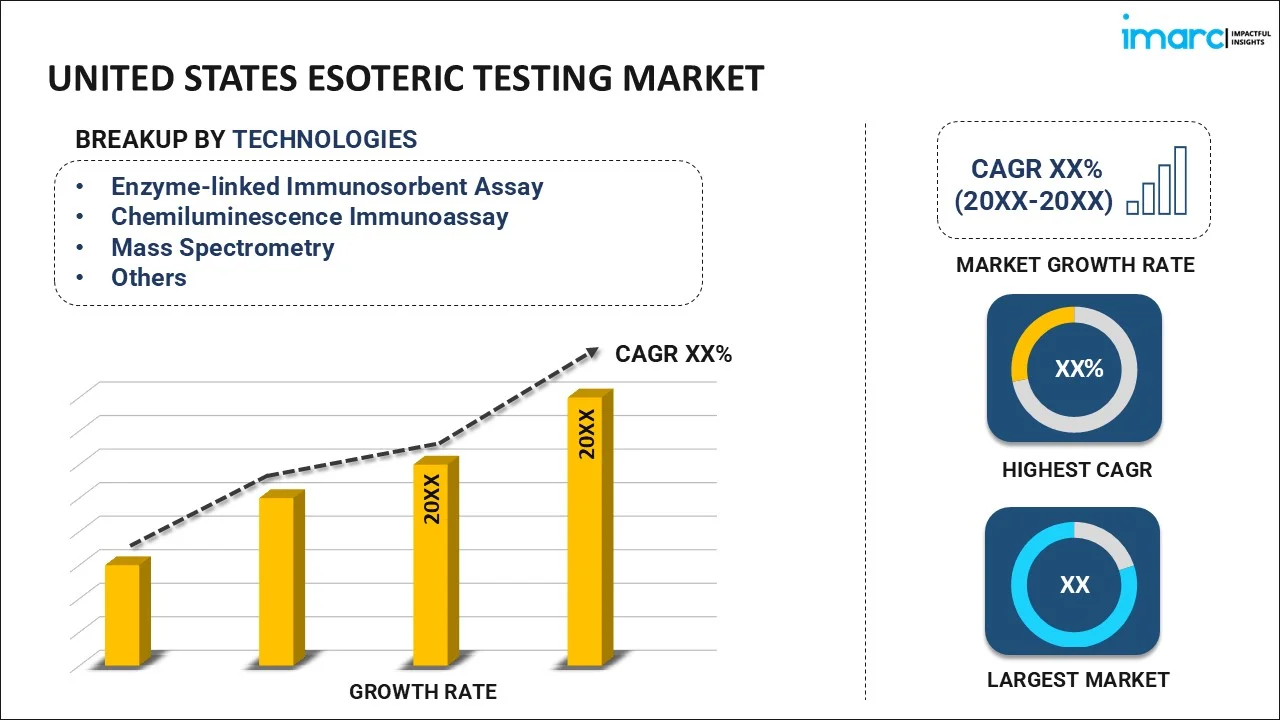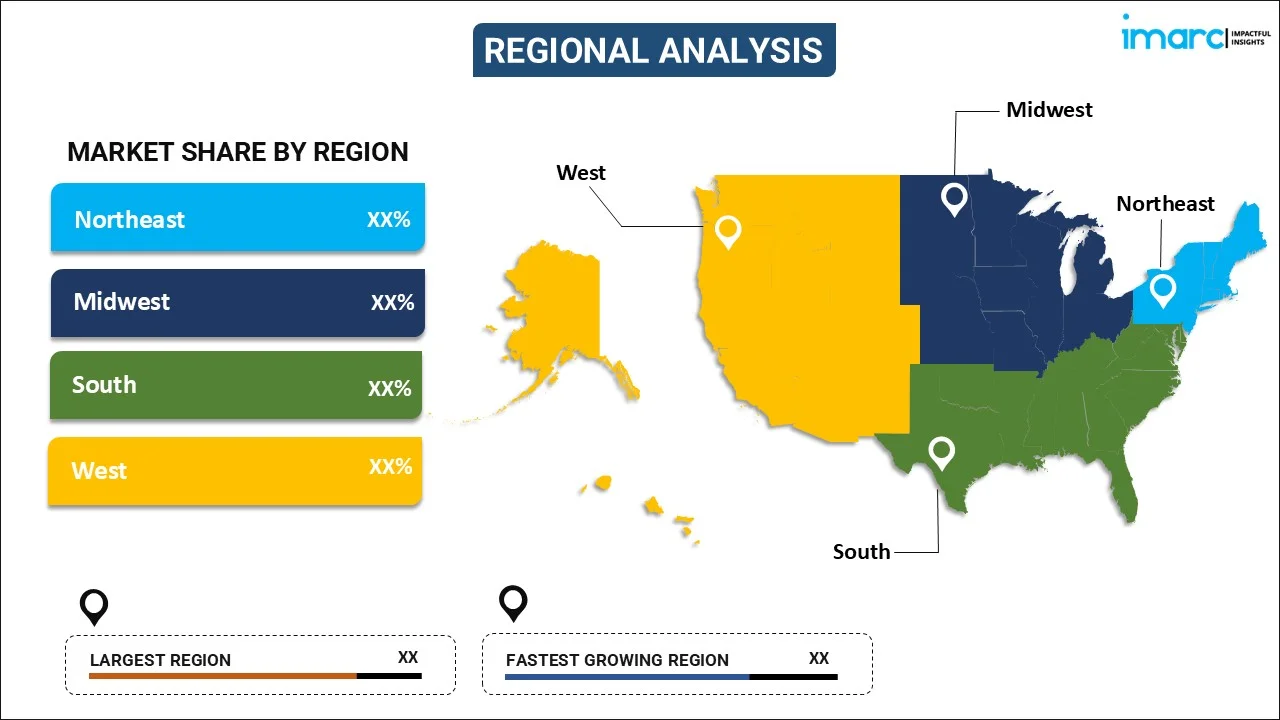
United States Esoteric Testing Market Report by Technology (Enzyme-linked Immunosorbent Assay, Chemiluminescence Immunoassay, Mass Spectrometry, Flow Cytometry, Polymerase Chain Reaction, and Others), Test Type (Infectious Disease Testing, Endocrinology Testing, Oncology Testing, Toxicology Testing, and Others), End User (Hospitals-based Labs, Independent and Referral Labs), and Region 2025-2033
United States Esoteric Testing Market Overview:
The United States esoteric testing market size reached USD 4.9 Billion in 2024. Looking forward, IMARC Group expects the market to reach USD 8.9 Billion by 2033, exhibiting a growth rate (CAGR) of 6.8% during 2025-2033. The rising prevalence of complex diseases, advancements in personalized medicine, the increasing demand for specialized diagnostic tests, significant technological innovations in genomics and proteomics enhance test accuracy and speed, and growing awareness and the need for preventive healthcare are propelling the growth of the market.
|
Report Attribute
|
Key Statistics
|
|---|---|
|
Base Year
|
2024 |
|
Forecast Years
|
2025-2033
|
|
Historical Years
|
2019-2024
|
| Market Size in 2024 | USD 4.9 Billion |
| Market Forecast in 2033 | USD 8.9 Billion |
| Market Growth Rate (2025-2033) | 6.8% |
United States Esoteric Testing Market Trends:
Increasing Prevalence of Complex and Rare Diseases
The rise in cases of rare and complex conditions necessitates specialized diagnostic tests that go beyond routine laboratory procedures, fueling the demand for esoteric testing. According to industry reports, rare diseases affect over 300 million people worldwide and are gaining recognition as a global health priority. According to the National Organization for Rare Disorders (NORD), a rare disorder is a condition that affects fewer than 200,000 Americans. There are over 10,000 rare diseases that together affect more than 30 million Americans. NORD is dedicated to the identification, treatment, and cure of these diseases through comprehensive education, advocacy, research, and service programs. According to the FDA, in 2023, over half of all the novel drugs and biologics approved by the FDA’s Center for Drug Evaluation and Research (CDER) and the FDA’s Center for Biologics Evaluation and Research (CBER) were to prevent, diagnose or treat a rare disease or condition.
Significant Technological Advancements
Innovations in molecular diagnostics, genomics, and proteomics enhance the accuracy and speed of tests, making them more effective for early disease detection and personalized treatment. For instance, in November 2023, Roche announced the launch of the LightCycler® PRO System based on the proven gold standard technology of the LightCycler® Systems that came before it. This new system raises the bar for performance and usability while bridging the gap between translational research and in vitro diagnostics. The LightCycler PRO System further complements Roche's molecular PCR testing portfolio, which includes solutions for a variety of healthcare professionals - from those performing research to those testing patients for cancer, infectious diseases, and other public health challenges. Similarly, in January 2024, Biognosys, a leader in next-generation proteomics services, software, and kits for life sciences research and drug development, announced the launch of the novel, proprietary P2 Plasma Enrichment method for single-well, single particle-type enrichment with market-leading performance and sensible, superior economics. P2-based plasma proteomics can be used for human or animal-model proteomics studies and clinical research.
United States Esoteric Testing Market News:
- In May 2024, Bruker Corporation announced the closing of its acquisition of ELITechGroup (“ELITech”) for €870 million in cash, excluding the carved out ELITech clinical chemistry business. ELITech is a differentiated, fast growing and profitable provider of systems and assays for molecular diagnostics (MDx), biomedical systems/specialty IVD, and microbiology, with FY 2023 revenue of approximately EUR 150 million, and more than 80% consumables revenue.
- In August 2024, Agilent Technologies Inc. announced that it has received FDA approval for the use of MAGE-A4 IHC 1F9 pharmDx (SK032) as a diagnostic tool to aid in identifying patients with synovial sarcoma who may be eligible for treatment with TECELRA ® (afamitresgene autoleucel, also known as afami-cel or ADP-A2M4), a MAGE-A4-directed engineered TCR T-Cell therapy.
United States Esoteric Testing Market Segmentation:
IMARC Group provides an analysis of the key trends in each segment of the market, along with forecasts at the country level for 2025-2033. Our report has categorized the market based on technology, test type, and end user.
Technology Insights:

- Enzyme-linked Immunosorbent Assay
- Chemiluminescence Immunoassay
- Mass Spectrometry
- Flow Cytometry
- Polymerase Chain Reaction
- Others
The report has provided a detailed breakup and analysis of the market based on the technology. This includes enzyme-linked immunosorbent assay, chemiluminescence immunoassay, mass spectrometry, flow cytometry, polymerase chain reaction, and others.
Test Type Insights:
- Infectious Disease Testing
- Endocrinology Testing
- Oncology Testing
- Toxicology Testing
- Others
A detailed breakup and analysis of the market based on the test type have also been provided in the report. This includes infectious disease testing, endocrinology testing, oncology testing, toxicology testing, and others.
End User Insights:
- Hospitals-based Labs
- Independent and Referral Labs
A detailed breakup and analysis of the market based on the end user have also been provided in the report. This includes hospitals-based labs and independent and referral labs.
Regional Insights:

- Northeast
- Midwest
- South
- West
The report has also provided a comprehensive analysis of all the major regional markets, which include Northeast, Midwest, South, and West.
Competitive Landscape:
The market research report has also provided a comprehensive analysis of the competitive landscape in the market. Competitive analysis such as market structure, key player positioning, top winning strategies, competitive dashboard, and company evaluation quadrant has been covered in the report. Also, detailed profiles of all major companies have been provided.
United States Esoteric Testing Market Report Coverage:
| Report Features | Details |
|---|---|
| Base Year of the Analysis | 2024 |
| Historical Period | 2019-2024 |
| Forecast Period | 2025-2033 |
| Units | Billion USD |
| Scope of the Report | Exploration of Historical Trends and Market Outlook, Industry Catalysts and Challenges, Segment-Wise Historical and Future Market Assessment:
|
| Technologies Covered | Enzyme-linked Immunosorbent Assay, Chemiluminescence Immunoassay, Mass Spectrometry, Flow Cytometry, Polymerase Chain Reaction, Others |
| Test Types Covered | Infectious Disease Testing, Endocrinology Testing, Oncology Testing, Toxicology Testing, Others |
| End Users Covered | Hospitals-based Labs, Independent and Referral Labs |
| Regions Covered | Northeast, Midwest, South, West |
| Customization Scope | 10% Free Customization |
| Post-Sale Analyst Support | 10-12 Weeks |
| Delivery Format | PDF and Excel through Email (We can also provide the editable version of the report in PPT/Word format on special request) |
Key Questions Answered in This Report:
- How has the United States esoteric testing market performed so far and how will it perform in the coming years?
- What has been the impact of COVID-19 on the United States esoteric testing market?
- What is the breakup of the United States esoteric testing market on the basis of technology?
- What is the breakup of the United States esoteric testing market on the basis of test type?
- What is the breakup of the United States esoteric testing market on the basis of end user?
- What are the various stages in the value chain of the United States esoteric testing market?
- What are the key driving factors and challenges in the United States esoteric testing?
- What is the structure of the United States esoteric testing market and who are the key players?
- What is the degree of competition in the United States esoteric testing market?
Key Benefits for Stakeholders:
- IMARC’s industry report offers a comprehensive quantitative analysis of various market segments, historical and current market trends, market forecasts, and dynamics of the United States esoteric testing market from 2019-2033.
- The research report provides the latest information on the market drivers, challenges, and opportunities in the United States esoteric testing market.
- Porter's five forces analysis assist stakeholders in assessing the impact of new entrants, competitive rivalry, supplier power, buyer power, and the threat of substitution. It helps stakeholders to analyze the level of competition within the United States esoteric testing industry and its attractiveness.
- Competitive landscape allows stakeholders to understand their competitive environment and provides an insight into the current positions of key players in the market.
Need more help?
- Speak to our experienced analysts for insights on the current market scenarios.
- Include additional segments and countries to customize the report as per your requirement.
- Gain an unparalleled competitive advantage in your domain by understanding how to utilize the report and positively impacting your operations and revenue.
- For further assistance, please connect with our analysts.
 Inquire Before Buying
Inquire Before Buying
 Speak to an Analyst
Speak to an Analyst
 Request Brochure
Request Brochure
 Request Customization
Request Customization




.webp)




.webp)












